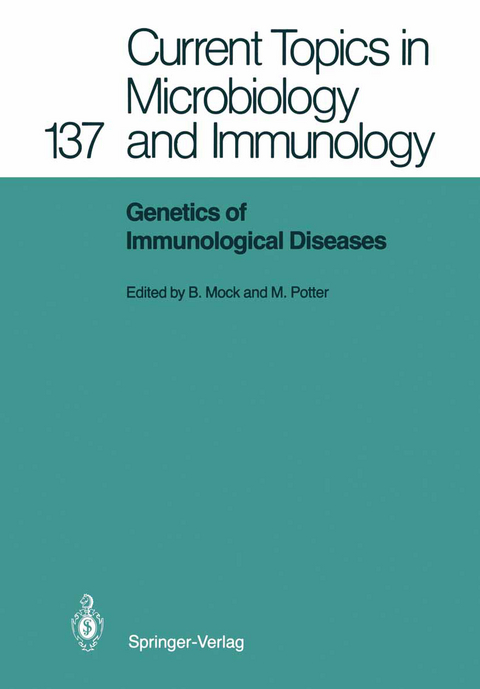
Genetics of Immunological Diseases
Springer Berlin (Verlag)
978-3-642-50061-9 (ISBN)
Michael Potter is Reader in the Philosophy of Mathematics at Cambridge University. He is the author of Sets (OUP, 1990), Reason's Nearest Kin (OUP, 2000), Set Theory and its Philosophy (OUP, 2004), and Mathematical Knowledge (edited with Mary Leng and Alexander Paseau, OUP, 2007).
I. Localizing and Cloning Genes.- The Long-Range Mapping of Mammalian Chromosomes.- The Use of Interspecific Mouse Crosses for Gene Localization: Present Status and Future Perspectives.- X-Chromosome Gene Order in Different Mus Species Crosses.- Bayesian Multilocus Linkage Mapping.- The Rat Gene Map.- Linkage and Synteny Homologies in Mouse and Man.- Molecular Analysis of the Aniridia - Wilms' Tumor Syndrome.- Approaching the Mouse Steel Locus from Closely Linked Molecular Markers.- II. Complex Loci Involved in the Regulation of Developmental and Immunological Processes.- The Mouse t Complex.- Probing Mouse Origins with Random DNA Probes.- Mouse t Haplotypes: A Tale of Tails and a Misunderstood Selfish Chromosome.- Contrasting Patterns of Evolution in the Proximal and Distal Regions of the Mouse t Complex.- From Phenotype to Gene: Molecular Cloning in the Brachyury (T) Locus Region.- Mouse Homeo Box Genes.- Murine Hox Genes - A Multigene Family.- Expression of the Homeobox Genes Hox 2.1 and 2.6 During Mouse Development.- Immunoglobulin Superfamily Genes.- Studies of V(D)J Recombination with Extrachromosomal Substrates.- Transcription Factors in Terminally Differentiated B Cells.- Selective and Neutral Evolution in the Murine Igh-V Locus.- The Organization of the Immunoglobulin Kappa Locus in Mice.- Conservation of the Organization of the pre-B Cell Specific VpreB1/VpreB2/?5 Loci in the Genus Mus.- The Omega and Iota Surrogate Immunoglobulin Light Chains.- MHC Class I Gene Expression by Tumors: Immunotherapeutic Implications.- Identification of Regulatory Elements Associated with a Class I MHC Gene.- Tind, Tsu and Tthy form a Trimolecular Complex Encoded Within the Tsu Locus on Chromosome 12 of the Mouse.- III. Allelomorphic and Mutant Phenotypes.- ImmunologicallyRelated Loc.- Lps Gene-Associated Functions.- The Immunobiology of the T Cell Response to Mls Locus Disparate Stimulator Cells.- Genetic Analysis of Serologically Undefined Determinants: A T Cell "Clonological" Analysis of the Mls System.- X-Chromosome Linked Mutations Affecting Mosaic Expression of the Mouse X Chromosome.- Mosaic Analysis of the Effects of a Novel X-Chromosome Mutation on the Haematopoietic System.- Autoimmunity.- The scid Mouse Mutant.- Aberrant Igh Locus Rearrangements in A-MuLV pre B Lines of scid Mice: Evidence for Deregulated D-J Recombination.- VH Family Usage and Binding Analyses of Polyreactive Monoclonal Autoantibodies Derived from Nonimmunized Adult BALB/c Mice.- Pleiotropic Effects of Deleterious Alleles at the "Motheaten" Locus.- Characterization of Mott Cell Hybridomas from Autoimmune "Viable Motheaten" Mutant Mice.- A Molecular Genetic Approach to gld "Autoimmune" Disease.- Genetic Analysis of BALB/cJ Subline Resistance to Actively Induced Experimental Allergic Orchitis (EAO) and Experimental Allergic Encephalomyelitis (EAE).- Neoplasia.- Genetic Control of Murine Susceptibility to 3-Methylcholanthrene-Induced T Cell Lymphoma.- Multigenic Control of Colon Carcinogenesis in Mice Treated with 1,2-Dimethylhydrazine.- Effect of the Gv-1 Locus on Moloney Ecotropic Murine Leukemia Virus Induced Disease in Inbred and Wild Mice.- Reverse Genetics Approaches for Cloning RIL-1, a Major Locus Involved in Susceptibility to Leukemia.- Genetic Map Location of Afr-1: Results From Four Genetic Crosses.- The Effect of the nude Gene on Plasmacytoma Development in BALB/cAn Mice.- Organization of the Distal End of Mouse Chromosome 4.- Susceptibility and Resistance to Plasmacytomagenesis: Possible Role of Genes That Modify Efficiency ofChromatin Repair.- A Molecular Characterization of BALB/c Congenie C.D2-Idh-1b, Lshr, Rep-1b, Pep-3bMice.- Infectious Diseases.- Analysis of Lsh Gene Expression in Congenic B10.L-Lshr Mice.- Identification of a Linkage Group Including the Bcg Gene by Restriction Fragment Length Polymorphism Analysis.- Continuous Expression of I-A by Murine Peritoneal Macrophages IS Linked to the Bcg Gene.- Chromosomal Location of the Gene Determining Restistance to Plasmodium chabaudi AS.- Summary.- From Phenotype to Gene: A Molecular Analysis of Complex Loci Involved in Developmental and Immunological Dysregulation.- Indexed in Current Contents.
| Erscheint lt. Verlag | 25.5.2012 |
|---|---|
| Reihe/Serie | Current Topics in Microbiology and Immunology |
| Zusatzinfo | XI, 335 p. 44 illus. |
| Verlagsort | Berlin |
| Sprache | englisch |
| Maße | 170 x 244 mm |
| Gewicht | 600 g |
| Themenwelt | Medizin / Pharmazie ► Medizinische Fachgebiete ► Dermatologie |
| Studium ► Querschnittsbereiche ► Infektiologie / Immunologie | |
| Schlagworte | Diseases • Genetics • immune response • infectious disease |
| ISBN-10 | 3-642-50061-7 / 3642500617 |
| ISBN-13 | 978-3-642-50061-9 / 9783642500619 |
| Zustand | Neuware |
| Informationen gemäß Produktsicherheitsverordnung (GPSR) | |
| Haben Sie eine Frage zum Produkt? |
aus dem Bereich


